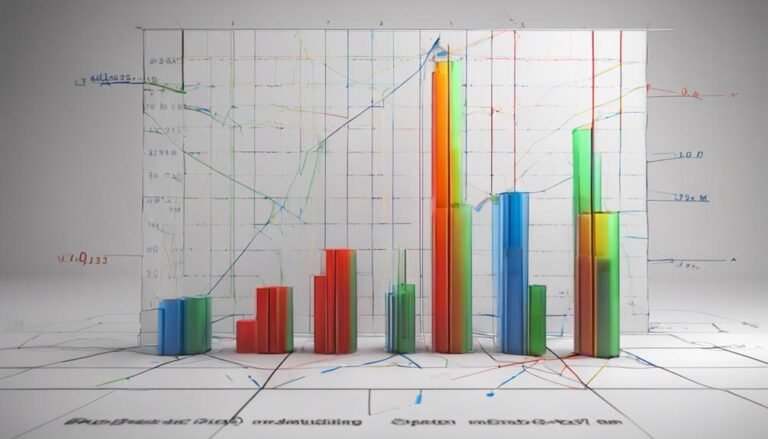Inside the Federal Reserve: Decoding Economic Powerhouse
The Federal Reserve, established in 1913, plays a crucial role in preventing financial crises and regulating the U.S. monetary system. Its goals include maximizing employment, guaranteeing price stability, and fostering economic growth. Through regulatory oversight, the Fed maintains financial stability by supervising banking institutions and managing risk. Structured decision-making processes and independence from political influence ensure effective policy implementation. Open market operations, managed by the FOMC, influence borrowing costs and consumer spending to achieve price stability and employment goals. By efficiently managing revenue streams and engaging in financial investments, the Fed impacts economic growth.
Key Takeaways
- The Federal Reserve was established in 1913 to prevent financial crises and regulate the economy.
- It aims to maximize employment, ensure price stability, and foster economic growth.
- The Fed maintains financial stability, supervises banking institutions, and protects against systemic crises.
- Its decision-making structure ensures policy autonomy, independence from undue influence, and effectiveness.
- Through open market operations and the FOMC, the Fed controls the money supply, sets monetary policy, and influences economic dynamics.
History and Establishment of the Fed
The establishment of the Federal Reserve System in 1913 marked a pivotal moment in U.S. financial history, shaping the country's approach to addressing financial panics and stabilizing the economy. Founded on the principles of providing a safe, flexible, and stable monetary and financial system, the Federal Reserve System aimed to prevent future financial crises through effective regulation and oversight.
The history of its establishment reflects the need for a centralized banking authority capable of managing the nation's monetary policy and ensuring economic stability. The founding principles of the Fed emphasized the importance of addressing financial panics, regulating banks, and maintaining stable prices and maximum employment levels. This historical backdrop laid the foundation for the Fed's critical role in the U.S. financial system.
Monetary Policy Goals and Objectives
In pursuit of economic stability and growth, the Federal Reserve System sets forth strategic monetary policy goals and objectives. These include:
- Maximizing Employment: The Fed aims to promote maximum sustainable employment through its monetary policy decisions. By influencing money supply and credit conditions, the Federal Reserve seeks to support job creation and reduce unemployment rates.
- Price Stability: Ensuring stable prices is another key objective of the Federal Reserve. By managing inflation and keeping prices relatively constant over time, the Fed aims to create a predictable economic environment for businesses and consumers.
- Economic Growth: Ultimately, the Federal Reserve's monetary policy goals are geared towards fostering sustainable economic growth. By balancing the objectives of maximizing employment and maintaining price stability, the Fed aims to support long-term prosperity and stability in the economy.
Regulatory Oversight and Financial Stability
Pursuing financial stability and regulatory oversight, the Federal Reserve System maintains a vigilant stance on overseeing the economy's integrity and safeguarding against risks.
Regulatory compliance is a key focus area for the Fed, ensuring that financial institutions adhere to established regulations to promote stability and transparency within the financial system.
The Fed actively engages in risk management practices to identify and mitigate potential threats to the economy, such as excessive leverage or market disruptions.
By supervising and regulating banking institutions, the Federal Reserve plays an essential role in protecting the financial system from vulnerabilities that could lead to systemic crises.
Through these efforts, the Fed works to uphold the integrity of the financial sector and promote sustainable economic growth.
Decision-Making Structure and Independence
Exercising its mandate for economic stability, the Federal Reserve System meticulously structures its decision-making processes to maintain independence and effectiveness in shaping monetary policy. The governance structure of the Fed guarantees robust policy autonomy through the following mechanisms:
- Board of Governors: Comprising seven members appointed by the President and confirmed by the U.S. Senate, the Board operates independently to make decisions in the best interest of the economy.
- Regional Federal Reserve Banks: With 12 banks spread across the country, each led by a president representing a different district, the regional banks contribute diverse perspectives to the Fed's decision-making process.
- Political Independence: The Fed's operational independence shields it from undue political influence, enabling a focus on long-term economic stability rather than short-term interests.
Open Market Operations and FOMC Role
The pivotal role of Open Market Operations and the Federal Open Market Committee (FOMC) within the Federal Reserve System underscores their significance in shaping the nation's monetary policy landscape. Open Market Operations involve the buying and selling of government securities to control the money supply, influence interest rates, and stabilize financial markets.
The FOMC, comprising the Board of Governors and Federal Reserve Bank presidents, is responsible for setting monetary policy, focusing on economic indicators, and forecasting strategies. By adjusting interest rates and managing market dynamics, the FOMC aims to achieve its dual mandate of price stability and maximum sustainable employment.
Its decisions have far-reaching policy implications, impacting borrowing costs, consumer spending, and investment decisions, thereby playing an essential role in steering the economy towards long-term stability.
Income Sources and Financial Operations
Exploring the financial landscape of the Federal Reserve System leads to an investigation of its income sources and operational mechanisms. The Federal Reserve's financial operations are vital for its functioning and influence on the economy. Key aspects include:
- Financial Investments:
- The Fed engages in financial investments such as U.S. government securities and foreign currency holdings to generate income and manage monetary policy.
- Revenue Streams:
- Revenue streams for the Federal Reserve come from various sources like interest on government securities, foreign currency investments, loans to depository institutions, and service fees.
- Operational Mechanisms:
- The Fed's operational mechanisms involve managing these revenue streams efficiently to support its goals of price stability, maximum employment, and economic growth.
Impact of Monetary Policy on Economy
In analyzing the impact of monetary policy on the economy, a critical examination of the Federal Reserve's strategic decisions and their implications on economic variables becomes paramount. The Federal Reserve's monetary policy plays a pivotal role in managing inflation dynamics and responding to labor market fluctuations. Through its actions, the Fed aims to achieve price stability and maximize sustainable employment. Below is a table highlighting how monetary policy influences these key economic factors:
| Monetary Policy Impact | Economic Variable |
|---|---|
| Controls inflation dynamics | Promotes price stability |
| Responds to labor market fluctuations | Strives for maximum sustainable employment |
Conclusion
In summary, the Federal Reserve System plays a pivotal role in maintaining financial stability and promoting economic growth in the United States.
One compelling statistic is that the Fed's balance sheet has expanded dramatically since the 2008 financial crisis, reaching over $8 trillion in assets in 2021.
This growth reflects the proactive measures taken by the Fed to support the economy during times of uncertainty and underscores its importance as a key player in shaping the economic landscape.







